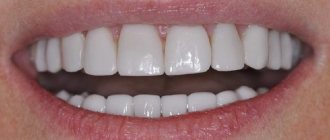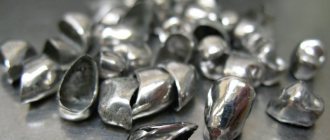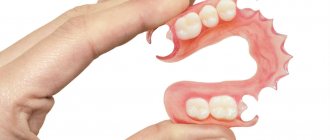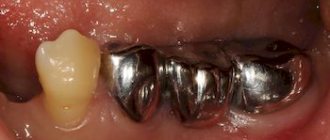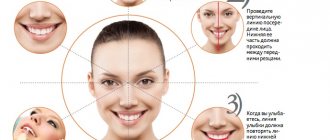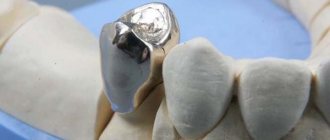What are the features of prosthetics for anterior teeth?
Any specialist understands perfectly well how important his smile is for a person, because it is a kind of business card, which means it is the first thing we pay attention to when meeting or getting to know each other. A lot depends on its beauty: the success of the transaction, personal relationships and - most importantly - the psychological state of its owner. Therefore, every time doctors are faced with the need to restore a front tooth, they are faced with an important and difficult task: to quickly and efficiently carry out the procedure. Prosthetics of the front tooth requires not only the correct recreation of the function, shape and color of the tooth, but also requires paying special attention to the “pink aesthetics”, that is, the gum.
In what cases are veneers used to restore front teeth?
If the problem is minor damage in the area of the front teeth, such as cracks or minor chips, as well as in cases where a person is not satisfied with the shape and color of the front teeth, it is advisable to correct the defect by installing ceramic veneers. A veneer is a thin porcelain plate no more than 0.3 mm wide, which is fixed to a ground tooth using composite cement. Modern materials from which veneers are made are very durable, hypoallergenic and can imitate almost all shades of natural enamel, as well as its transparency. Many modern dental clinics in Moscow, which provide prosthetics for front teeth using this orthopedic design, can offer the installation of veneers during one visit to the doctor. With careful care, such ceramic restorations will serve their owner for at least ten years.
Plastic or ceramics – which is better?
Many people ask this question, and it is not at all random. Most patients are captivated by the fact that the cost of plastic crowns is not high. Such crowns are installed even despite numerous shortcomings, but after a while disappointment sets in.
The advantages of plastic crowns are as follows:
- the cost is not high;
- no difficulties during installation;
- excellent imitation of natural crowns.
Example of teeth before and after restoration
The disadvantages include:
- the material is soft, it wears off quickly, the crown is destroyed;
- plastic has a porous structure, all paints from products are absorbed into it;
- Decay products penetrate into the intergingival space, as a result of which pathogenic microorganisms begin to multiply.
As you can see, this design has quite a lot of shortcomings; before installation, all of them must be taken into account. Now, as for ceramic crowns, they also have advantages and disadvantages.
The positive points include:
- the structure is dense, food dyes will not penetrate and will not change color;
- long service life;
- the ability to completely imitate the color of real teeth;
- does not wear out after time.
Zirconium crown
The only drawback of this design is the high cost.
Caring for the removable structure
People who have removable dentures must follow a number of rules. The thing is that the functioning of the product, as well as its service life, depends on this. At first, the sensations may be unusual. The process of taking it off and putting it on can cause some difficulties.
General rules for care are as follows:
- Remember that the prosthesis is fragile. It reacts positively to chewing loads, but as for impacts, this can cause damage. In this regard, the structure must be handled carefully.
- Remove the structure after eating and rinse under water. Solid particles may remain in the furrows and must be removed.
- Pay special attention to the part that is used for fixation. It is in contact with periodontal tissues, which means there should be no signs of dirt.
- After removing the denture, brush your existing teeth in your mouth.
- When carrying out any procedures with a prosthesis, be careful, as you can damage any part of it.
- Most of these structures should always be kept damp so they can maintain their shape. At night, place the prosthesis in a container with a solution or plain water.
The result pleases for a long time
Regardless of what material artificial teeth are made of, they must be carefully cared for. Due to severe contamination, an unpleasant odor will appear, which is almost impossible to get rid of. Don’t forget about a preventive trip to the hospital, because the structure should be examined by a professional.
What are Lumineers and when are they used?
Lumineers are another type of orthopedic plates designed primarily to correct the color and shape of the tooth surface. The installation of lumineers, unlike veneers, is carried out in one visit and does not involve grinding of the dentition. That is why there is no need to wear temporary structures before installing them. Lumineers also have an undeniable advantage over composite restorations: thin ceramic plates do not darken over time.
However, there are also disadvantages. Since lumineers are installed on an unground surface, it is sometimes very difficult to achieve a tight fit to the teeth. In addition, the tooth on which the lumineer is attached differs from the natural dentition in size and shape, so it is not recommended to correct local defects with its help.
How is prosthetics performed for severely damaged front teeth?
Modern prosthetics of anterior teeth in many cases involves the use of an old proven method - installing a crown. This prosthesis is a protective frame that is put on the ground remaining part of the tooth and completely repeats the shape and color of the lost crown part. The need to use this orthopedic design arises in cases where the tooth is destroyed by more than 50%. Before installing it, the doctor grinds down the tooth (what’s left of it), and only then puts on the “cap,” that is, the crown itself. Modern specialists prefer to prosthetize the front teeth using the most aesthetic type of crowns on a frame made of lithium disilicate, feldspathic ceramics and zirconium dioxide.
What removable dentures look like in the photo
Of course, from an aesthetic point of view, fixed structures will compare favorably with removable dentures. Despite the constant improvement of removable products, they will always cause discomfort to patients when speaking and cause irritation of the mucous membrane. Also, when using them, especially in the first time after installation, diction may suffer. In addition, their service life is quite short; even the best devices will last about 5-7 years.
However, there are times when it is not possible to resort to permanent prosthetics. This may be due to significant loss of most teeth, complete edentia, or due to financial capabilities. Not all patients have the opportunity to undergo expensive implantation; for them, removable devices will be a good way out of this situation.
Removable dentures are affordable, performed quickly, and allow you to restore the aesthetics of your smile and restore functionality to your teeth. Dentures cope quite well with chewing food and help avoid problems associated with disruption of the digestive system and changes in the shape of the face.
Acrylic dentures made of hard plastics
Acrylic structures are especially popular among patients who are faced with partial or complete absence of teeth. Dentures are held in the mouth due to the suction effect or fixed with hooks if supporting teeth remain. The designs look quite natural, allowing the patient not to worry about appearance, but they can cause significant discomfort during use and reduce the sensitivity of taste buds.
Acrylic dentures: before and after photos
Soft and elastic removable dentures
Soft dentures (nylon, Acree Free, polyurethane or Quadrotti) are leaders in the field of fixed prosthetics when it comes to aesthetics. The base of the product, that is, the gum bed, is made of soft and elastic plastic. Pinkish-transparent, it perfectly imitates gums, and plastic artificial teeth look very natural. The dentures do not cause any discomfort to the patient, are very flexible and hypoallergenic, and are suitable for use in the presence of weakened and sensitive mucous membranes. They are fixed in the mouth on gums or hooks that have a pinkish tint - they are also made of plastic.
Nylon dentures
Clasp structures with a metal base
Dentures on a metal arch are used in cases of partial absence of teeth. They can be attached to adjacent teeth using hooks (but then it is better not to use them to eliminate defects in the frontal smile area, since the hooks can be noticeable when talking or eating). The best aesthetics on the front teeth can be achieved with fixation with locks or using telescopic crowns.
Clasp prosthesis: before and after photos
How are missing or severely damaged teeth restored?
Dental implantation is considered the most reliable and optimal option for restoring missing or unrecoverable incisors. Implants do not require grinding of adjacent teeth, and their installation has virtually no contraindications. Implantation is considered the best option for prosthetic treatment of anterior teeth for periodontitis. When reconstructing teeth in the anterior region, specialists prefer to work using an accelerated method, that is, to carry out one-stage implantation. It makes it possible to completely restore a tooth in one visit to the doctor and maintain the correct contour and volume of the gums. The patient is given an implant, and immediately after that a temporary crown is installed, which completely restores the aesthetics of the smile. However, it must be remembered that one-stage implantation is possible only under certain conditions. Otherwise, if for some reason it is impossible to immediately install a temporary crown, the doctor still does not let the patient go “with a hole instead of a tooth,” but temporarily covers it with a removable denture.
How much do the best dentures cost?
| Construction type | Price |
| Crowns | From 12,000 rubles for metal ceramics to 40,000 for zirconium crowns |
| Veneers | 20,000 – 25,000 rubles per unit |
| Partial denture on implants | From 70,000 rubles |
| Classic bridge | On average 8,000 – 15,000 rubles |
| Complete denture on implants | 150,000 – 600,000 rubles for one jaw. Depends on the number and brand of implants implanted. |
| Butterfly prosthesis | From 4,000 rubles depending on the material |
| Plate dentures | From 20,000 rubles. 30,000 – 35,000 rubles for Quadrotti prostheses |
| Removable complete denture | On average 35,000 rubles for a full Acry Free prosthesis |
| Removable denture on mini-implants | 100,000–120,000 rubles for one jaw |


